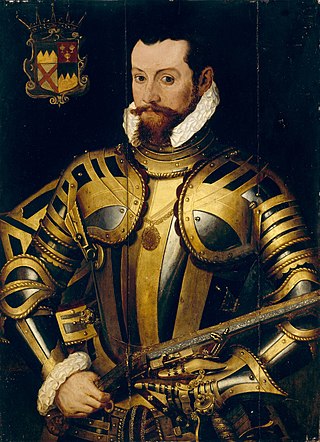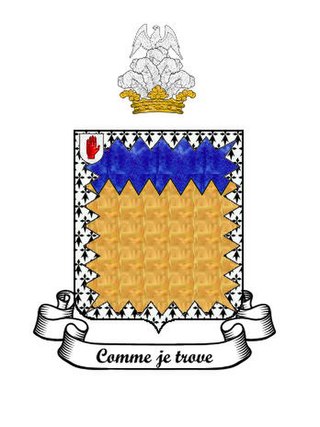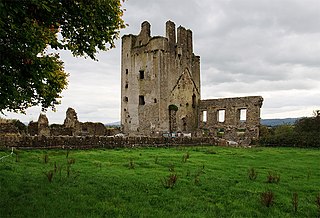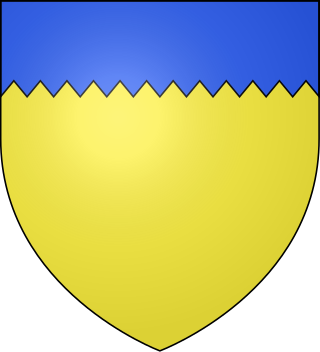This article needs additional citations for verification .(November 2024) |
| |||||
| Centuries: | |||||
|---|---|---|---|---|---|
| Decades: | |||||
| See also: | Other events of 1569 List of years in Ireland | ||||
Events from the year 1569 in Ireland.
This article needs additional citations for verification .(November 2024) |
| |||||
| Centuries: | |||||
|---|---|---|---|---|---|
| Decades: | |||||
| See also: | Other events of 1569 List of years in Ireland | ||||
Events from the year 1569 in Ireland.

Thomas Butler, 10th Earl of Ormond and 3rd Earl of OssoryPC (Ire), was an influential courtier in London at the court of Elizabeth I. He was Lord Treasurer of Ireland from 1559 to his death. He fought for the crown in the Rough Wooing, the Desmond Rebellions, and Tyrone's Rebellion. He fought his rival, Gerald FitzGerald, 14th Earl of Desmond in the Battle of Affane in 1565.

Gerald FitzGerald, 14th Earl of Desmond, also counted as 15th or 16th, owned large part of the Irish province of Munster. In 1565 he fought the private Battle of Affane against his neighbours, the Butlers. After this, he was for some time detained in the Tower of London. Though the First Desmond Rebellion took place in his absence, he led the Second Desmond Rebellion from 1579 to his death and was therefore called the Rebel Earl. He was attainted in 1582 and went into hiding but was hunted down and killed.
Sir Walter Butler, 11th Earl of Ormond and 4th Earl of Ossory (1559–1633), succeeded his uncle Black Tom, the 10th earl, in 1614. He was called "Walter of the Beads" because he was a devout Catholic, whereas his uncle had been a Protestant. King James I intervened and awarded most of the inheritance to his uncle's Protestant daughter Elizabeth. Ormond contested the King's decision and was for that insolence detained in the Fleet Prison from 1619 until 1625 when he submitted to the King's ruling. He then found a means to reunite the Ormond estate, by marrying his grandson James, who had been raised a Protestant, to Elizabeth's only daughter.
James Butler, 3rd Earl of Ormond, was a noble in the Peerage of Ireland. He acceded to the title in 1382, and built Gowran Castle three years later in 1385 close to the centre of Gowran, making it his usual residence, whence his common epithet, The Earl of Gowran.
Richard Butler, 1st Viscount Mountgarret was the son of Piers Butler, 8th Earl of Ormond and Lady Margaret Fitzgerald. He married his half first cousin Eleanor Butler, daughter of Theobald Butler of Polestown, the illegitimate brother of the 8th Earl of Ormond. He was created 1st Viscount Mountgarret in 1550.
Events from the year 1680 in Ireland.

Earl of Carrick, in the barony of Iffa and Offa East, County Tipperary, is a title in the Peerage of Ireland.
There have been four baronetcies created for persons with the surname Butler; two in the Baronetage of Ireland and two in the Baronetage of the United Kingdom. As of 2014 two of the creations are extant.
Events from the year 1570 in Ireland.
Events from the year 1602 in Ireland.
Events from the year 1565 in Ireland.
Edmund Butler, 6th Chief Butler of Ireland and nominally Earl of Carrick, was an Irish magnate who served as Justiciar of Ireland during the difficult times of the Scottish invasion from 1315 to 1318 and the great famine of 1316 to 1317.

Sir Edmund Butler of Cloughgrenan, was an Irish noble and the second son of James Butler, 9th Earl of Ormond and Lady Joan Fitzgerald. He was a scion of the House of Ormond, and a rebel against the Tudors.
Iffa and Offa East is a barony in County Tipperary, Ireland. This geographical unit of land is one of 12 baronies in County Tipperary. Its chief town is Clonmel. The barony lies between Iffa and Offa West to the west, Middle Third to the north-west and Slievardagh to the north-east. It is currently administered by Tipperary County Council. The entire barony lies within the geographic remit of the Roman Catholic Diocese of Waterford and Lismore with the exception of the parish of Clerihan which is in the Roman Catholic Archdiocese of Cashel and Emly.

Earl of Glengall was a title in the Peerage of Ireland that was created in 1816 for Richard Butler, 10th Baron Cahir. The subsidiary title of Baron Cahir in the Peerage of Ireland was first created in 1542 for Thomas Butler, who was a descendant of The 3rd Earl of Ormond. James "Gallda" Butler was the son of the 3rd Earl and Catherine FitzGerald of Desmond. "Gallda" Butler married a daughter of MacWalter and together they had one son, Piers (1425-1464). The title was re-created in 1583 with the unusual remainder to heirs general of the first baron, which made his great-nephews, Theobald Butler and Thomas Prendergast, co-heirs. Prendergast ceded the title to Theobald Butler, preferring that the title should follow the strict male line.

Sir Thomas Butler, 1st Baronet of Cloughgrenan, was an Irish nobleman.

John Butler of Kilcash was an Irish landowner and soldier. A younger son of James Butler, 9th Earl of Ormond and brother of Thomas Butler, 10th Earl of Ormond, he received Kilcash Castle as appanage. He fought in the Desmond–Ormond conflict and was badly wounded in 1563, just before the Battle of Affane. He was the start-point of the Kilcash branch of the Ormonds and the father of Walter Butler, 11th Earl of Ormond.

Butler is the name of a noble family whose members were, for several centuries, prominent in the administration of the Lordship of Ireland and the Kingdom of Ireland. They rose to their highest prominence as Dukes of Ormonde. The family has produced multiple titles such as Baron Cahir, Baron Dunboyne, Viscount Ikerrin, Viscount Galmoye, Viscount Mountgarret, Viscount Thurles, Earl of Carrick, Earl of Kilkenny, Earl of Ormond, Earl of Ossory, Marquess of Ormonde and Duke of Ormonde. Variant spellings of the name include le Boteler and le Botiller. The Butlers were descendants of Anglo-Norman lords who participated in the Norman invasion of Ireland in the 12th century. The surname has its origins in the hereditary office of "Butler (cup-bearer) of Ireland", originating with Theobald Walter, 1st Chief Butler of Ireland. The arms of later family members depicted three cups in recognition of their original office.
Elizabeth Preston, Countess of Desmond and 2nd Baroness Dingwall was the only daughter of Thomas Butler, 10th Earl of Ormond, called Black Tom, a lone Protestant in his Catholic Old English family. Her marriage and inheritance were manipulated by James I to keep Black Tom's inheritance out of the hands of his Catholic successor, Walter of the beads and bring them into the hands of his Scottish favourite Richard Preston, Lord Dingwall.